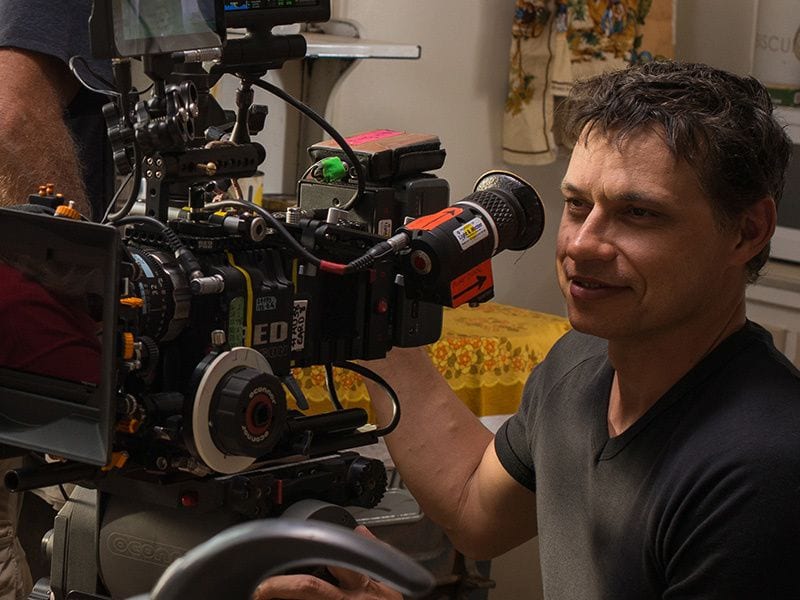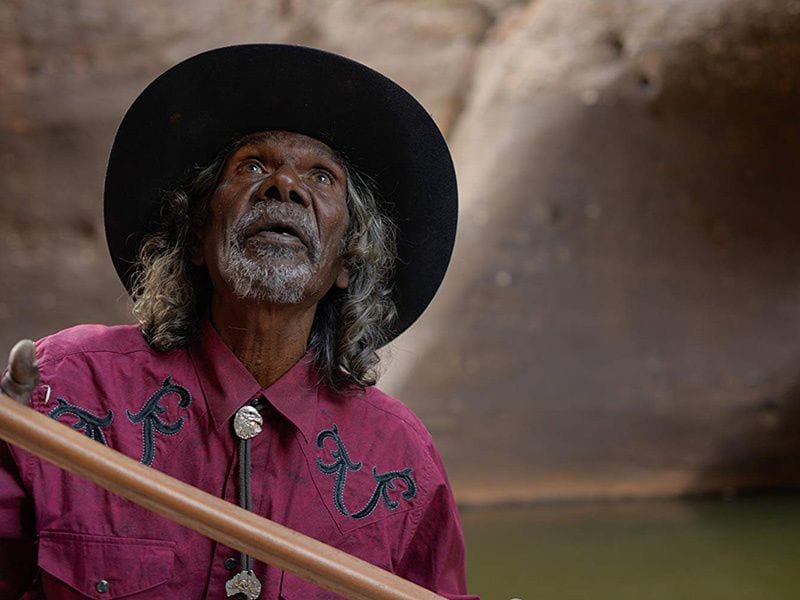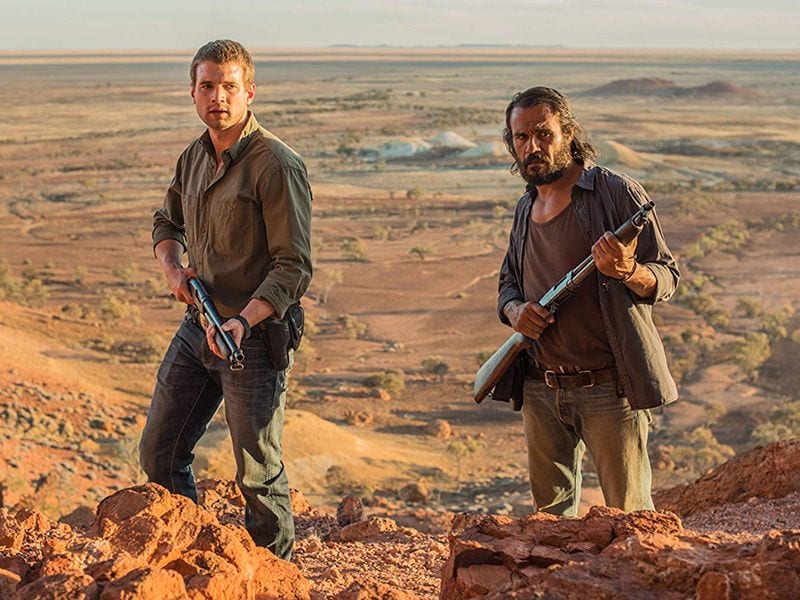
“…there is a future still to fight for, but there is a hell of a loss to mourn.” – Ivan Sen
Indigenous Detective Jay Swan (Aaron Pederson) arrives in the frontier town of Goldstone on a missing persons inquiry, that unearths a web of crime, corruption, human trafficking, and the exploitation of aboriginal lands. While he finds his relationship with the town’s sole police officer Josh (Alex Russell) an uneasy one, both men have a past to be made peace with and a future to fight for, beginning with justice in Goldstone.
The first appearance of the character of Swan was in Indigenous filmmaker Ivan Sen‘s 2013 crime thriller Mystery Road, in which the detective returned to the Outback to investigate the murder of a girl. “I approached Goldstone as a stand alone film,” explains Sen, who has also executive produced the six part television series Mystery Road that revolves around a disappearance on a cattle ranch that once again dredges up the past.
Prior to his Indigenous detective character, Sen’s feature directorial debut was the semi-autobiographical Beneath Clouds (2002), followed by Dreamland (2009) and Toomelah (2011), the latter which screened to acclaim in the Un Certain Regard category at the Cannes Film Festival.
In conversation with PopMatters, Sen discusses the Indigenous presence in the Australian film industry and how an increasing openness to Indigenous creative expression is offset by challenges that are yet to be overcome. He also reflects on film as philosophy and the capacity for film to impact our everyday reality, as well as how Goldstone represents a shift in his approach to connecting himself to his films.
Why filmmaking as a means of creative expression? Was there an inspirational or defining moment?
There was a defining moment that led me down the film path, but it was step by step. I grew up in a small country town in the ’70s and ’80s. We had one radio station and two televisions channels. The local video store and the cinema was my escape from the often depressing collective consciousness of the small town. But film was my connection to the outside world.
I had a love of film and books from a young age, though there were no role models or influencers around me until my mother remarried while I was in High School. My new stepfather happened to be the local newspaper editor. He had a camera and he gave me access to a dark room. From a young age I’d always had a keen interest in taking photos, but never (until then) had a chance to touch a camera.
This newspaper connection led me to the city where I would study photography. One of the subjects involved producing AV presentations with my images, and the big moment came when I watched my first slideshow. It was a profound moment to see my photos on a big screen with a soundtrack. I was overcome with emotion and I realised it was time to change my path. One day alone in the dark screening room, I knew I had to make films. First I thought I might just be a DP because it was safer, but it wasn’t enough. As a photographer I was already telling stories with the frame, so I couldn’t let that spark die. I wanted to tell stories, not just film them. So from then on, I woke up with a spring in my step, and I kind of still do.
Over the course of your career, what are your thoughts on the issue of inclusion of Indigenous crew within the Australian filmmaking industry? I believe for your feature debut Beneath Clouds (2002), you worked with a mixed crew and it was reported by Variety that you shared feelings of frustration with producer Teresa Jane-Hanson about the limited numbers of Indigenous crew in the industry? (Boland, Michaela (2001). “Black and White Issues has Gray Areas“, Variety. 382: 22.)
Beneath Clouds was one of the earlier Indigenous writer, director films, and maybe the first to be developed in Screen Australia’s Indigenous Unit. Since then, things have changed a lot. There is now an Indigenous Film/TV community, a substantial number of Indigenous writers, directors and producers. Screen Australia has played a major role in developing this network, and the Indigenous Branch is now celebrating 25 years of achievement. The department has funded ten of my projects including four feature films, so it has been very important in my career.
But it’s still difficult to find Indigenous crew and it’s something I still think needs more attention. From my own experience, Indigenous people are highly creative, which comes from a very deep place. When faced with a less creative option, I feel Indigenous people shy away from it. I think it’s something in the blood, where creativity has a played a major role in the structure of Indigenous culture for over sixty thousand years.
Speaking with Amy Adrion, director of the documentary Half the Picture (2018), which focuses on gender inequality in the film industry, we spoke about how art inherently benefits from diversity. With that in mind, we must contemplate the extent to which the cinematic language has been denied an opportunity for richness and growth.
Further still, even if we do reach a point of equality, it does not silence the question of what has been lost. I’d be interested to engage your thoughts on this point, and whether you feel Australian cinema has been denied an opportunity for richness and growth through prejudice?
Until the late ’90s, Indigenous Australians were mostly represented on screen by non-Indigenous people. They were often depicted as one dimensional, unimportant fragments on the landscape of the White Australian narrative. Now, Indigenous Australians are telling our own stories about our own people, from our own perspectives. Now, Australian film culture is being enriched by, and the Australian identity is being influenced by it.
Also, the importance of Indigenous people seeing themselves on screen in an authentic way, cannot be measured. It inspires Indigenous people and helps claim back an identity that has been stepped on since colonisation.
Indigenous cinema and television is quietly on its way to becoming a success story in Australia. Indigenous stories are largely untapped, they give fresh perspectives and ideas. But the challenge is for the broader audience to accept them. Television is a more accepting medium in Australia because of access, and is generally free to air. To attract Australian audiences into cinemas to watch Indigenous films is still challenging, and is a part of a wider issue about Australian films struggling to make an impact at the box office without any quota protection.
Interviewing artist and filmmaker Rebecca Miller, she told me: “…if they are made honestly, all pieces of art are self portraits of the person making them.” Would you agree and broadening the discussion, how do you view the place of Goldstone within your body of work? Do you see an evolution of ideas, or is the storyteller’s journey in part a repetitive act?
I think a big part of living is growth. Sometimes it happens naturally or we force it, but to force it, we need to be conscious of it. My first few films were more self reflective and then I started to reflect on other people’s lives. I mean, if I shoot an environmental portrait of someone in their workspace, the person in that environment is not me, but it’s my mirror I’m holding up to the character. And I make choices about how that reflection appears. I think that’s where I’m heading with film now.
Before I went into filmmaking, my objective was to shoot stills for National Geographic, but in a way, what I’m doing now is similar. Where I’m presenting a reflection of small pieces of the world, and aligning them with my sensibilities, this is kind of where Goldstone sits for me, as well as my films into the future. So after making several self-reflective films, I have largely let go of that approach, and now absorb myself with other people and their struggles.
My next film is a romantic sci-fi and the following one will be a war drama. Both have no Indigenous Australian content, but they will carry my Indigenous sensibility.
Is it necessary to have seen Mystery Road, or did you approach Goldstone with the intent that they could be viewed independently?
I approached Goldstone as a stand-alone film. Mystery Road does provide some backstory details, but it’s really not essential to the viewing experience. I wanted Goldstone to have its own world and I wanted it to feel like a different type of film from Mystery Road, so for this to happen I needed to make it stand independently.
One of the strengths of the story is the lack of romantic heroism. Goldstone leads one to question whether it’s a cynical or optimistic film. But perhaps the film challenges defining life and stories by these two extreme terms, rather they are both, and at the same time neither.
Indigenous Australians have heard it all before from the people in charge. From the Mission managers of the ’30s, to the successive State and Federal governments, with one hand they want to help, and with the other hand they steal land, culture, and spirit. I think Indigenous people are cynical of the Government for obvious reasons, but there’s a strong optimism within the spirit of Indigenous Australia, and that optimism is why we are still alive, and still fighting for justice. So cynicism and optimism can be found in all Indigenous cinema because it’s inherent in our experience as Indigenous Australians.
The last shot in Goldstone of Detective Jay Swan is of a man who is reclaiming what was taken from him. It’s a moment of pain and it’s a moment of profound euphoria at the same time. It still gives me goose bumps. It’s there on his face, that there is a future still to fight for, but there’s a hell of a loss to mourn at the same time.
The film has an inclination towards the philosophical, as the characters self-reflect amidst themes of destiny and one’s place in the world. Do you perceive film as a medium that fits well with philosophy? Is there a validity to the idea that filmic storytelling can serve a purpose to help us as storytellers and audiences to understand ourselves and our world?
Philosophy is a term I try not to use. The fact that it exists seems to unhinge what it is trying to represent, and that’s the problem with film as philosophy. When you are conscious of it, in terms of thought process, it becomes undermined and loses power. I think there are rare moments in film that do present meaning that can be felt and understood as opposed to conscious attempts of thought. And those moments will never be the same for everyone.
Maybe that’s why the world is no quick fix. I kind of think that’s how the world works, how things in society change. You look at the [United States] Democrat and Republican conventions, of the people standing there in the crowd, you get the feeling that there may be no hope. The only thing that can bring them together is time, the accumulation of small subtle moments of understanding over time. And yes, I believe film can and has played a role in this.
Film can change the world, it can help bring it together. As humans we often try hard to fix things instantly, but time will have its way with us, like it does with everything.
Beneath the surface of a crime thriller, Goldstone is a look at displacement, disconnect, and loss of identity. While the story of Jay and the girls together look to the individual displaced, Josh’s story looks to the common and universal feeling of having lost one’s sense of self, and how a different path has been taken. Another character talks about how the world is not made for us, but we are made for it, and specifically uses the term ‘destiny’. This comment is important to consider when addressing the film’s displacement, disconnect and loss of identity. At some juncture in the story, we reach the question of free will and the ability to be authors of our own identity, versus the struggle to escape cycles of cause and effect that are the basis of our concept of ‘fate’ or ‘destiny’.
One of the things I was told when I was a ten-year-old boy living in a poor housing commission estate was that I wanted too much from life. It came to a response from an older friend. He spoke about the potential profitability of a private garbage collecting service on the estate. I remember replying with: “Why would you want to do that your whole life?” The friend gave me that reply that to make money was enough, no matter how mundane the job. This was the mentality of where I grew up and later as I travelled overseas, I felt how similar things actually are around the world.
The line in Goldstone, “the world was not made for you, you were made for it”, has come from my youth, but it’s something I found in places all over the world. I’ve never believed in fate, I believe we make our choices and that’s what we become. As a writer, it’s fundamental to the process. Of course we can leave ourselves more open to fate, but this is also a choice we make.
The struggles to overcome our surroundings may be something that will always be in my work because it’s something I identify with. My single mother did it, and there was a lot for her to lose. She took us three siblings out of that housing estate, for a better place, and she lost her family to a large extent. She sacrificed that part of her for us kids, and I personally lost a sense of my Indigenous identity as a result. But I made an effort to reclaim it as soon as I got the chance.
Filmmakers have told me that editing is the best training ground for a director. I’d be interested to hear your thoughts on how each of your editing experiences have impacted your approach to writing and directing your successive films.
Well, editing is incredibly important for me because that’s where I really find the mistakes I’ve made, and try to fix them! For directors who don’t stay close to the editor, they are missing the dirty work, missing all the crap decisions they make, and are coming in when it’s all been fixed for them. I’m sure that being an editor influences my writing because I see the shots as I write, but I also see how they will edit together.
I also write with a strong idea about where the music will be over a certain part of the script. All of these early thoughts and decisions at script stage are heavily influenced by my hands on editing of previous films.
Speaking with Carol Morley for The Falling (2014), she explained: “You take it 90 percent of the way, and it is the audience that finishes it. So the audience by bringing themselves: their experiences, opinions and everything else to a film is what completes it.” If the audience are the ones that complete it, does it follow that there is a transfer in ownership?
As a writer and director, you get a chance to transplant your perspective into other minds. Your deepest thoughts merge into the consciousness of strangers that happens through a process described by Sergei Eisenstein as a “synchronisation of the senses”. This picture and sound mix is what no other medium has the ability to do. It’s a profound thing, to see an audience watch the film you have written and directed. Something very strange occurs and it’s hard to put it into words. That’s probably why I do it, because I can’t explain the feeling that gives.
Filmmaker Christoph Behl remarked to me: “You are evolving, and after the film, you are not the same person as you were before.” Do you perceive there to be a transformative aspect to the creative process, and should the experience of watching a film offer the audience a transformative experience?
I think every time we step out into the world we are somehow changed. It’s only when some dramatic moment or immersive activity occurs that we really take notice of it. The shoot process can have a big impact on you, especially if it’s in a life-changing environment like the desert. I remember watching some films in the desert as we were going into photography forGoldstone. I had seen these films before, but watching them out in the desert in a tent was a strange experience. I felt emotions from them I had never felt before.
Transformative cinema is what I consider to be the real cinema. There’s all kinds of cinema out there, but when it can make you feel something you haven’t felt in real life, that’s special. And that’s what gets me out of bed with a spring in my step, just like that moment many years ago when I felt my path change.





